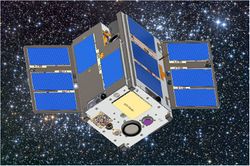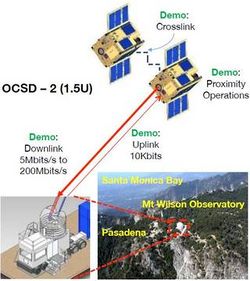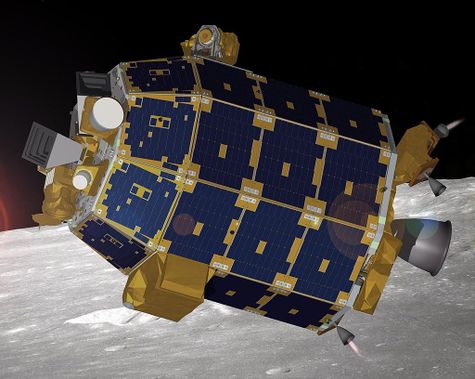The Field of Optical Communications
What follows is a high level overview of notable milestones in the development of space-based optical communications.
MIT Lincoln Labs LLCD/LADEE
Nasa's Lunar Laser Communication Demonstration (LLCD) was a rousing success that demonstrated duplex laser communications at previously unheard-of speeds between lunar orbit and ground stations on Earth (These download speeds were at times faster than the ground lines on Earth when distributing downloaded scientific data). The LLCD's space component was attached as an optical payload to the larger scientific satellite LADEE. The LLCD project operated on the 1.5-micron band with maximum downlink speeds of 622Mbs. The project featured a 1kHz squarewave acquisition signal and could measure its round-trip Time of Flight (TOF) to within 200 psec.
All systems operated at or above expected levels, and it was demonstrated that an optical link could be established without human-in-the-loop interaction. Several demonstrations of the system were executed, and are described below.
High Speed Telemetry
The typical 50kbps telecommunications via RF were replaced during a lock-on window by a 2.7Mbps optical telemetry transmission. This information was then plotted graphically in real time against the slower RF data.
High Volume Download
During one experiment, test data from another LADEE experiment was transmitted via the optical link. The 1GB of data was transmitted in under five minutes (error-free). The same amount of data would have consumed every RF window for three days to transmit.
The information was then relayed to scientist on the ground using existing infrastructure that was often slower than the optical link itself. This process was executed several times at the request of LADEE scientists and gave them an unprecedented amount of data to process.
Webcam Livestream
An HD webcam was setup in the operations center and broadcast its information up and around the moon before coming back. Viewers would see their movements about seven seconds delayed on the big screen. "Needless to say, this was a very popular feature of the demonstration" [1].
Ground Station Handover
During testing with the LLGT, cloud cover became stronger than anticipated. With very little time delay, the link was turned off, locked onto the LLOT (one of the back-up stations), and then reactivated perfectly. This was the first demonstration of a control "Handover" and showed the systems robustness.
Open-Loop Optical Lock On
After lock on had become routine, LADEE was loaded with predefined instructions to turn on the LLST system. Then when LADEE next came into view, without any RF communication, the LLST system was activated and locked on to the ground.The entire transmission window was then operated entirely upon optical commands, and RF was never used.
The Ground and Space terminals (LLGT and LLST)
The Lunar Lasercom Space Terminal (LLST) optics consisted of a 10cm reflective telescope capable of ~15uRad beam width. It was connected via fiber to the modem where transmissions up to .5W were processed. This module was used for uplinks as well. LADEE was the host satellite to this experiment, and LLST's optics were gimballed on a side-mount of the satellite.
The ground stations for the LLCD project consisted of the primary Lunar Lasercom Ground Terminal (LLGT), and the two backup terminals, the Lunar Lasercom OCTL Terminal (LLOT) and the Lunar Lasercom Optical Ground System (LLOGS).
LLGT
The LLGT contained four 15cm 10W transmit telescopes and four 40cm Downlink telescopes. Its downlink telescopes were linked by fiber to an array of superconducting nanowire single photon detectors. All eight of these telescopes were then contained within an environmentally controlled enclosure. The entire LLGT device was transportable, and was thoroughly tested near MIT Lincoln Labs before being transported to White Sands where it stayed for the tests.
LLOT
The LLOT is a 60W transmitter with six uplink apertures. The downlink receiver utilizes a super conducting nanowire photon counting array and exhibits 78Mbits downlink with tracking and uplink acquisition abilities.
LLOGS
Based upon the earlier OGS, the LLOGS was LLCD's third backup solution. Created with a 1 meter downlink telescope, with 3 outrigger telescopes for uplinking and acquisition, this 60W transmitter and receiver is most similar to SSI's optical communications modules. It uses hardware post processing to downlink at 39Mbs, and a photo-multiplier tube array as its primary sensor.
JPL 1U Optical Comms Terminal
Although not yet flown, JPL has mature designs for a 1U lasercomm terminal to be flown on a future CubeSat. The terminal, occupying 1U of a proposed 6U satellite, features a 7 cm transmit/receive aperture with a optical tracking system capable of achieving on the order of 10 urad angular accuracy.[2] The proposed terminal uses a 0.5W laser of unspecified frequency, assumes a ground telescope 1m in aperture diameter (using superconducting nanowire photon detectors), and predicts a data rate between 150 and 200 Mbits/s. Such satellites have been proposed for lunar and interplanetary missions, for which their small mass and high data rates give them considerable potential. [3]
NASA Small Satellites Technology Project
| OCSD-1 (AeroCube 7A) | |
|---|---|

| |
| Organization | NASA, The Aerospace Corporation |
| Launch provider | ULA - Atlas V |
| Launch date | October 8, 2015 |
| Launch site | Vandenberg AFB |
| Orbit | LEO 1000 x 1200 km x 63.4° |
| Size | 1.5U |
| OCSD-2 (AeroCube 7B/C) | |
|---|---|

| |
| Organization | NASA, The Aerospace Corporation |
| Launch provider | SpaceX - Falcon 9 |
| Launch date | July 2016 (projected) |
| Launch site | Vandenberg AFB |
| Orbit | Unknown |
| Size | 2 x 1.5U |
The Small Spacecraft Technology Program invests in the development and demonstration of a range of technologies and capabilities and engages the talents of a broad community of researchers and technologists from government, industry and academia. Currently, the SSTP funds and/or manages 34 projects that are organized under the four program elements. Of these, two pertain to optical communications.
Optical Communications and Sensor Demonstration (OCSD)
The Optical Communications and Sensor Demonstration (OCSD) project, managed by NASA with payloads built by The Aerospace Corporation, addresses two cross-cutting capabilities of value to many future small spacecraft missions: high-speed optical transmission of data and small spacecraft proximity operations. Optical data rates demonstrated by OCSD are expected to be 200 megabits per second (Mb/s) or higher, a factor of 100 increase over current high-end CubeSat communications systems. [4]
The optical communications system on OCSD differs from other space-based laser communication systems because the laser is hard-mounted to the spacecraft body. The beam is pointed by controlling the orientation of the entire spacecraft. This makes the laser system much more compact than anything previously flown in space. The attitude control system developed for these satellites includes a pair of miniature star trackers, devices that measure the position of stars for navigational purposes. These star trackers were designed to enable pointing to an accuracy of 0.05 degrees, which is 20 times the precision previously demonstrated in a satellite of this size. See here for a detailed overview of the OCSD satellites' system specifications.
OCSD-1
OCSD-1 was launched on October 8, 2015. OCSD-1 was the first of three planned satellites, carrying a 6W fiber laser with a 0.7° divergence half angle designed to downlink with a 30 cm ground telescope. This was later enlarged to 80 cm. [5] Projected data rates from OCSD-1 range from 5 to 100 Mbits/s. On October 30, 2015, NASA acknowledged that the Attitude Determination and Control System (ADCS) onboard the satellite was not functioning properly, preventing a test of the satellite's optical communications systems.[6] OCSD-1 does not contain any fine beam steering systems, relying wholly on the ADCS for optical alignment. The stated minimum ADCS precision for basic link function is 0.15°; NASA and The Aerospace Corporation have claimed the optical link could achieve data rates above 1 Gbit/s with an higher precision ADCS.
OCSD-2 (A/B)
OCSD-2 is scheduled for launch during 2016 aboard a currently unidentified Falcon 9 launch from Vandenberg AFB. The first such launch is currently scheduled for July. OCSD-2 contains the remaining two of the three planned satellites, which will launch as a single 3U unit and separate into 2 independent satellites. The OCSD-2 A and B payloads will attempt satellite-earth communications at speeds in excess of 500 Mbit/s, with the primary purpose of demonstrating technologies for satellites operating in proximity to each other. It is unclear what systems will differ between the OCSD-1 and OCSD-2 payloads.
Space Optical Communications Using Laser Beam Amplification (SOCLBA)
The Space Optical Communications Using Laser Beam Amplification (SOCLBA) project will provide a capability to amplify a laser beam that is received in a modulating retro-reflector (MRR) located in a satellite in low Earth orbit. The results of the first year’s work (2014) show amplification factors of 60 times the power of the signal beam. However, there has been little published information since then. The program is led by researchers at the University of Rochester.
